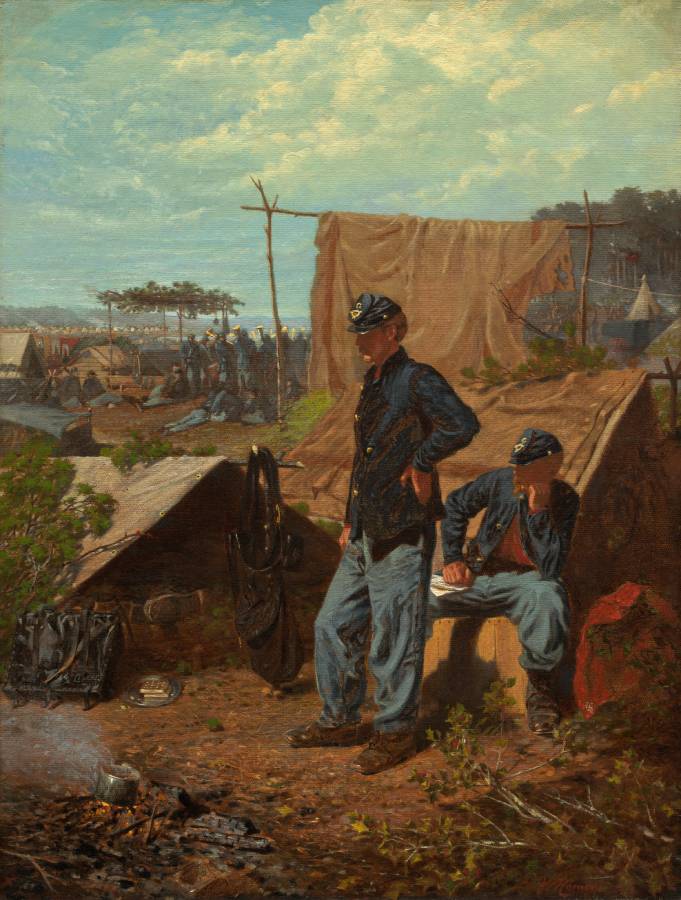Homer, Winslow (1836-1910)
Home, Sweet Home
c.1863
Oil on canvas, 54.6 x 41.9 cm
National Gallery of Art, Washington
In a camp, two soldiers wearing blue uniforms are lost in thought as they listen to a military band playing music in the background in this vertical painting. Their uniforms consist of midnight-blue jackets, stone-blue pants, and flat-topped, brimmed hats. Brass buttons line the open fronts of their jackets, and a gold-colored emblem is affixed to the tops of their caps. One soldier, at the center of the painting, stands facing our left in profile with one hand on his hip. Another, to our right, sits in front of a tent, also looking to our left. The seated soldier’s knees are spread wide. One hand rests on at least two pieces of paper on his thigh, and he rests his chin in the other hand, also propped on his thigh. A low, triangular tent, about waist-high, is pitched to the left of the standing solider. The inside is dark but closer inspection reveals the bottom of one boot, presumably belonging to a solider lying down inside. At the lower left of the painting, gray smoke drifts up from a pot on a campfire. A knapsack and a pewter plate holding waffle-like hardtack are laid near the tent. A few branches cover the dirt ground to our right. A tan cloth draped over an arbor-like structure of sticks forms a partition between the two soldiers and the rest of the camp, dividing the composition. Rows of tents extend into the distance. A band of soldiers plays music in the distance, light glinting off their gold horn instruments. A row of tents is visible in the deep distance, perhaps across a body of water. The horizon line comes about two-thirds of the way up the composition, and puffy white clouds drift across the pale blue sky above. The exhibition of Home, Sweet Home in the spring of 1863 auspiciously marked Winslow Homer‘s debut as a painter. The painting was enthusiastically admired. “Winslow Homer is one of those few young artists who make a decided impression of their power with their very first contributions,” a critic observed. “He at this moment wields a better pencil, models better, colors better, than many” more established artists. Home, Sweet Home was a remarkable technical achievement for someone, like Homer, who was largely self-taught. In this, one of his very first paintings, Homer‘s contemporaries were able not only to take clear measure of his large artistic gifts, but also to sense qualities of mind and character that were important parts of what one of them called the “promise of a worthy art future.” They saw those qualities in the “delicacy and strength of emotion” of Home, Sweet Home, its “real feeling” and lack of sentimentality. They saw them, too, in its directness, and in its intelligence: “There is no clap-trap about it. Whatever of force is in the picture is not the result of trickery, and is not merely surface work, not admitting of examination, but painstaking labor directed by thought.” And they saw them in its modernity: It is “inspired by a fact of to-day.” Two union soldiers (infantrymen, as the insignia on their caps show) listen as the regimental band plays “Home, Sweet Home”. In what might almost be a description of Homer‘s painting, and of the kind of experience Homer himself must have had when he visited the front in 1861 and 1862, the Union general Nelson A. Miles described an occurrence in the valley of the Rappahannock: Late in the afternoon our bands were accustomed to play the most spirited martial and national airs, as “Columbia,” “America,” “E. Pluribus Unum,” “The Star-spangled Banner,” etc., to be answered along the Confederate lines by bands playing, with equal enthusiasm, “The Bonny Blue Flag,” “Southern Rights,” and “Dixie.” These demonstrations frequently aroused the hostile sentiments of the two armies, yet the animosity disappeared when at the close some band would strike up that melody which comes nearest the hearts of all true men, “Home, Sweet Home,” and every band within hearing would join in that sacred anthem with unbroken accord and enthusiasm. The title of Homer‘s painting evokes the “bitter moment of home-sickness and love-longing” that the song inspired in the soldiers. The title also refers to the soldiers’ “home,” shown with all of its domestic details–a small pot on a smoky fire, a tin plate holding a single piece of hardtack–which Homer, who did the cooking and washing when he was at the front, knew intimately, and which, with surely intended irony, are very far from “sweet.” (Text by Nicolai Cikovsky Jr., published in the National Gallery of Art exhibition catalogue, Art for the Nation, 2000)
